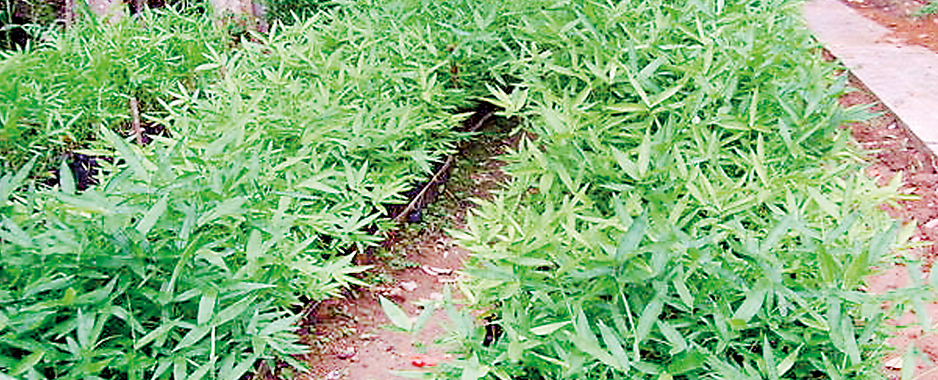Why not get things booming with bamboo?
World Bamboo Day fell on September 18. Technology and research has elevated bamboo, once considered “the poor man’s timber”, into the wood of the 21st Century. In fact its more recent epithet is “green gold”.
The re-awakening of bamboo culture in Sri Lanka was with the development of tissue culture techniques for mass-scale propagation of bamboo at the Institute of Fundamental Studies and the inception of the Riverine Bamboo Project under the Presidential Secretariat in 1998 and its continuation under the Mahaweli Authority in 2004 to the present day. Unfortunately, the government’s interest in bamboo development has slowly dwindled over the past several years whereas many other countries have augmented research and development activities on bamboo for realising its vast potential for income generation and environment protection.
Bamboo is an eco-friendly plant with a long history of traditional uses. There are many species and varieties of bamboo each with their own set of unique properties that enable their use in various applications. Bamboo wood is strong and flexible and its density is comparable to that of hard woods with a tensile strength that out matches steel. Novel technologically advanced products such as bamboo veneer and plywood, medium and high density fibre board, bamboo reinforced concrete, laminated bamboo, reinforced bamboo beams, parquet etc., are now produced on industrial scales. Their market is rapidly expanding with enforcements in regulations for preventing timber exploitation. Further these are also aesthetic and ecological substitutes for tropical hard wood. Houses can now be constructed using material made entirely of bamboo. Elegant and expensive ones as well as cheaper affordable houses made of bamboo have been designed. Earthquake resistant bamboo houses are a great advantage in countries prone to such disasters.

Young bamboo plants
Bamboo industry requires an adequate and regular supply which can only be possible with well-managed bamboo plantations. Thus, bamboo cultivation has become necessary even in countries where bamboo was once abundant. The average yield of a tropical bamboo forest is a mere 20% of that of a bamboo plantation. Managing a bamboo plantation is costly but a high yield of better quality product that generates a substantial net profit is possible. Bamboo is a grass that re-grows after cutting. Therefore unlike timber trees, this perennial needs to be planted only once and harvested regularly for over 50 years. Furthermore, it is fast growing and can be harvested after four to six years of planting.
The greatest advantage of bamboo is its adaptability. Bamboo can be grown in a wide range of climates ranging from tropical to cool temperate zones and up to an altitude of 4500 m.
Sri Lanka’s native species are small reed bamboos (bata) except for the two, Bambusa bambos (katu una) and Bambusa vulgaris (una), the yellow and green varieties which are also common in other countries of this region. Many species were introduced especially during the British period, a collection of which is found in the Royal Botanic Gardens, Peradeniya. The most outstanding of these is giant bamboo (Dendrocalamus giganteus) which is the largest of the bamboos with a high biomass. This is ideal for erosion control especially riverbank protection because of its massive underground rhizome and roots system which binds soil particles. D. asper, D. latifolius (with edible shoots) and D. hookeri are also large bamboos recommended for riverbank protection. A species which should be introduced is Guadua angustifolia found in Brazil and Costa Rica, sought after for construction of houses and buildings. This has strong straight culms and the timber is said to be as hard and durable as jak timber!
The late Prof. Aries Kovoor, who was instrumental in initiating the Riverine Bamboo Project with the objective of planting three rows of Giant bamboo along the banks of the Mahaweli envisioned that this will generate a bamboo resource for production of paper pulp. At a planting density of 200 clumps per Ha, a mature plantation of giant bamboo could give a potential yield of 50 MT per Ha, by harvesting 10% of its culms (poles). The sale of unprocessed poles alone can give an income of Rs. 200,000/ per ha per year. A metric ton of paper pulp has a market value of US $ 500 to 700. Fifty metric tons of bamboo can be processed into 20 MT of pulp and the potential income by exporting paper pulp could amount to US $10,000/ per ha per year. Thus development of bamboo-based industries could lead to an economic potential far exceeding that of tea!
The Riverine Bamboo Project of the Mahaweli Authority of Sri Lanka instrumental in producing bamboo propagules by tissue culture techniques claims to have distributed many hundred thousands of D. hookeri, which have been planted along river and stream banks in various parts of the Island. Those planted on the Mahaweli river bank in Doluwa (inaugural planting) in 2006 have attained massive proportions with more than 100 culms per plant. Although the original concept was to grow three rows of giant bamboo (D. giganteus) along Mahaweli, D. hookeri, a comparatively lower yielding species was planted in a single row, not only along parts of Mahaweli, but also along other river and stream banks. However, the larger extent of planting will give rise to a considerable biomass and has great promise.
It is now timely to harvest bamboo poles from the older clumps for various end uses. Bamboo is a grass, the more it is cut the more it grows. The removal of older mature culms will encourage new growth ensuring sustainable and economical resource utilization. Extents available for harvesting and utilization should be provided by the Mahaweli Authority and the Forest Department as such information is crucial for entrepreneurs who wish to undertake bamboo industries.
Furthermore, problems related to utilization of bamboo need to be identified. Presently the Divisional Secretary’s permission to transport bamboo is an impediment to its greater use. Thus, logistics and legalities of harvesting and transport need to be addressed in order to encourage and promote bamboo utilization.
A recommendation is to initiate small scale projects to utilize bamboo immediately until such time higher-scale industrial applications are possible. A craft which can be undertaken at household level is production of incense sticks, match sticks or tooth picks. These crafts do not require much processing other than slitting and polishing the product. Once such projects have been initiated, further improvements and production of more sophisticated items using machinery could expand the industry. Suitable craftsmen identified as trainers should be sent to India or China where regular training programmes take place.
At the same time there are many more places where bamboo planting could be done. Considering the recent episode of crocodile infestation leading to attacks on humans on the eroding Nilwala river bank, it is recommend that all resources are provided and a bamboo planting programme undertaken as a measure to overcome such disasters.
The Riverine Bamboo Project is a clear manifestation of what research and technology development could lead to. Many countries invested in bamboo research knowing its future potential. Research is the foundation leading to discoveries and technology development and civilization thrives on discoveries. Who thought that this humble plant would be rediscovered with new dimensions to become the wood of the 21st century? Bamboo is a $25 billion industry centred in China and is considered green gold. It is a pity that we Sri Lankans are still sitting on this gold mine!
The writer can be contacted on shantharamanayake@yahoo.com
Follow @timesonlinelk
comments powered by Disqus



















